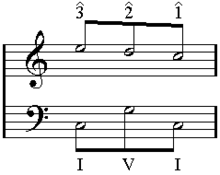Primary tone
In Schenkerian analysis, the primary tone or head tone (German: Kopfton) is the starting tone of the fundamental line. The fundamental line itself originates as an arpeggiation of the tonic chord, filled by passing tones:
- In accordance with the arpeggiation from which it stems, the fundamental line exhibits the space of a third, fifth, or octave. These spaces are filled by passing tones.[1]
Free Composition, Example 4. Fundamental line in relation to the tonic triad. The possible primary tones are shown as whole notes: 



The primary tone therefore necessarily is one of the higher tones of the tonic chord, ![]()
![]()
![]()
The fundamental line descends from its primary tone to the tonic, ![]()
- To man is given the experience of ending, the cessation of all tensions and efforts. In this sense, we feel by nature that the fundamental line must lead downward until it reaches

Sources
- Schenker, Heinrich (1979). Free Composition, § 5.
- Schenker (1979), § 10.
gollark: God has been dead since 1996 *anyway*.
gollark: They've discussed this before. Apparently making candles burn dimmer/brighter.
gollark: > seeing ads, ever
gollark: As planned.
gollark: Instead of forgetting to remember, just forget to forget.
This article is issued from Wikipedia. The text is licensed under Creative Commons - Attribution - Sharealike. Additional terms may apply for the media files.
